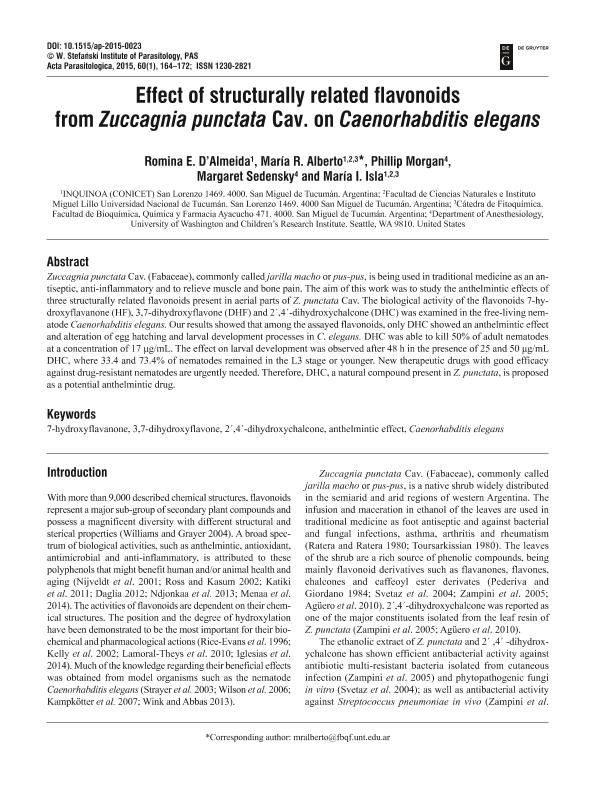Artículo
Effect of structurally related flavonoids from Zuccagnia punctata Cav. on Caenorhabditis elegans
D'almeida, Romina Elisa ; Alberto, Maria Rosa
; Alberto, Maria Rosa ; Morgan, Phillip; Sedensky, Margaret; Isla, Maria Ines
; Morgan, Phillip; Sedensky, Margaret; Isla, Maria Ines
 ; Alberto, Maria Rosa
; Alberto, Maria Rosa ; Morgan, Phillip; Sedensky, Margaret; Isla, Maria Ines
; Morgan, Phillip; Sedensky, Margaret; Isla, Maria Ines
Fecha de publicación:
03/2015
Editorial:
De Gruyter
Revista:
Acta Parasitologica
ISSN:
1230-2821
Idioma:
Inglés
Tipo de recurso:
Artículo publicado
Clasificación temática:
Resumen
Zuccagnia punctata Cav. (Fabaceae), commonly called jarilla macho or pus-pus, is being used in traditional medicine as an antiseptic, anti-inflammatory and to relieve muscle and bone pain. The aim of this work was to study the anthelmintic effects of three structurally related flavonoids present in aerial parts of Z. punctata Cav. The biological activity of the flavonoids 7-hydroxyflavanone (HF), 3,7-dihydroxyflavone (DHF) and 2′,4′-dihydroxychalcone (DHC) was examined in the free-living nematode Caenorhabditis elegans. Our results showed that among the assayed flavonoids, only DHC showed an anthelmintic effect and alteration of egg hatching and larval development processes in C. elegans. DHC was able to kill 50% of adult nematodes at a concentration of 17 μg/mL. The effect on larval development was observed after 48 h in the presence of 25 and 50 μg/mL DHC, where 33.4 and 73.4% of nematodes remained in the L3 stage or younger. New therapeutic drugs with good efficacy against drug-resistant nematodes are urgently needed. Therefore, DHC, a natural compound present in Z. punctata, is proposed as a potential anthelmintic drug.
Archivos asociados
Licencia
Identificadores
Colecciones
Articulos(INQUINOA)
Articulos de INST.DE QUIMICA DEL NOROESTE
Articulos de INST.DE QUIMICA DEL NOROESTE
Citación
D'almeida, Romina Elisa; Alberto, Maria Rosa; Morgan, Phillip; Sedensky, Margaret; Isla, Maria Ines; Effect of structurally related flavonoids from Zuccagnia punctata Cav. on Caenorhabditis elegans; De Gruyter; Acta Parasitologica; 60; 1; 3-2015; 164-172
Compartir
Altmétricas



